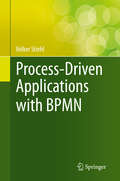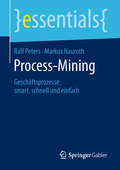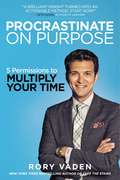- Table View
- List View
Process-Driven Applications with BPMN
by Volker StiehlHow can we optimize differentiating business processes and exploit their full potential? Here Volker Stiehl provides answers, utilizing the various options that the BPMN (Business Process Model and Notation) standard offers for planning, implementing and monitoring processes. The book presents an approach for implementing an architecture for applications that strives to find a balance between development and maintenance costs, sustainability, scalability and fault tolerance; that meets flexibility requirements without becoming inordinately complex itself; and that keeps the end application as abstract as possible from the system landscape in which it operates. Based on the semantic enhancements found in version 2. 0 of the BPMN standard, which have made it possible to execute process models, his approach exploits BPMN to create and run complete application architectures. In this context, BPMN is not just used to model the business processes of the application, as the "B" in BPMN might suggest; but also to model and execute the integration processes between the systems. Throughout the book, the software package SAP Process Orchestration is used to illustrate the implementation of the proposed architecture, yet all recommendations are intentionally kept generic so that they can be implemented on any other comparable platform as well. Software architects, IT managers, software developers and project managers, as well as students of information and business technology will find the book a valuable resource. The proposed application architecture offers them a detailed blueprint, the principles of which they can use to plan and implement process-driven distributed applications.
Process-Mining: Geschäftsprozesse: smart, schnell und einfach (essentials)
by Ralf Peters Markus NaurothDie Autoren geben einen praxisorientierten Einstieg in Process-Mining mit unternehmensbezogenen Anwendungsfällen und einer Marktübersicht der Software, die hilft, Geschäftsprozesse schnell, smart und einfach zu gestalten. Auf Basis von Log-Daten der Geschäftsvorgänge erstellt Process-Mining automatisch Modelle der Ist-Abläufe, kann diese mit Soll-Abläufen vergleichen und helfen, Geschäftsprozesse zu optimieren. Weitere Anwendungen von Process-Mining sind u.a. Governance, Risk und Compliance Management, IT-Migration und -Implementierung sowie Entwicklung digitaler Geschäftsmodelle. Process-Mining ist gerade auch für kleinere und mittelgroße Unternehmen von großer Bedeutung für die Wettbewerbsfähigkeit.Die Autoren Ralf Peters ist selbstständiger Unternehmensberater und Interimsmanager. Er unterstützt Unternehmen in Transformationsphasen, bei Post-Merger-Integrationen, IT-Implementierungen sowie dem Einsatz von Process-Mining. Prof. Dr. Markus Nauroth lehrt Wirtschaftsinformatik an der Hochschule Mainz und verantwortet u.a. als Studiengangleiter den Bachelor-Studiengang Angewandte Informatik. Zuvor war er als Unternehmensberater in London und New York tätig.
Process-Oriented Dynamic Capabilities
by Ralf PlattfautThis book introduces a process-oriented dynamic capability framework to study both, service innovation and Business Process Management (BPM). Results from applications in several case studies and surveys are reported. They reflect, e. g. , capability development and maturity models. Based on these findings, a method to support service innovation is introduced. This method can help organizations in developing new service business models in a more effective and efficient way. In today's networked service society, service innovation becomes increasingly important. Reasons for this development can be found in the transformation of economies and in the growing importance of product-service systems. The concept of service innovation is related to Business Process Management (BPM) and shares several important traits. They both are process-oriented dynamic capabilities to adapt (service) processes to changing environments.
Processes and Production Methods (PPMs) in WTO Law
by Christiane R. ConradDespite a decades-long debate, starting with the 'Tuna-Dolphin' disputes of the 1990s, questions on the status of national regulatory measures linked to processes and production methods in WTO law have yet remained unsolved. Likewise, labelling requirements relating to unincorporated aspects of a product's life cycle remain strongly contested. These ongoing disputes at the WTO as well as global social and environmental challenges related to economic activities show how topical and important the search for adequate answers still is. Processes and Production Methods (PPMs) in WTO Law identifies and comprehensively analyses the key legal problems concerning such measures, setting them in the context of the current debate and its economic and regulatory background. Christiane R. Conrad develops a new approach to this debate which draws on the objectives and established economic rationales of the WTO Agreements.
Processing Vehicles Used in Violent Crimes for Forensic Evidence
by Christopher D. DuncanWhile there are numerous books on crime scene investigation and the processing of crime scenes, few focus on the processing of vehicles. Whether the crime took place in the car or the car was used to transport the suspect or victim—and, as such, is a secondary scene—investigating vehicles presents several unique challenges. Processing Vehicles Used in Violent Crimes for Forensic Evidence fills this void providing the technical instruction sorely needed in this area of crime scene investigation. The book is geared not only to investigators who process vehicles involved in general crimes but also with a specific focus on violent crimes. Coverage includes details as to how investigators should document the vehicle in a logical and methodical manner that is easily understood and replicated for various scenes. By identifying the unique challenges caused by working in the tight quarters of a vehicle—especially in photographing the vehicle, the evidence within it, and how to best find, collect, document, and preserve the evidence—the author provides a unique reference for investigators. Special attention is paid to documenting shooting incidents, the proper detailing and documentation of bullet trajectories, bloodstain documentation, and processing vehicles for other biological, impression, and physical evidence. Key Features Presents crime scene collection and preservation techniques and methodology specific to vehicle-related considerations Outlines the unique challenges, and step-by-step procedural requirements, necessary to conduct a vehicle or vehicle-related scene investigation Addresses types of various evidence for vehicles—including fingerprint, blood, DNA, bullet and casing, and fire debris—which are common primary or secondary crime scenes While the book is geared toward crime scene investigators and forensic technicians who process vehicles used in crimes, it will be an invaluable resource for criminal justice and forensic science students, attorneys, death investigators, fire investigators, accident scene investigators, and scene reconstructionists.
Procrastinate on Purpose
by Rory VadenFrom the New York Times bestselling author of Take the Stairs--a bold new way to get things done. New York Times bestselling author and sales-performance trainer Rory Vaden brings his high-energy approach and can-do spirit to the most nagging problem in our professional lives: stalled productivity. Millions are overworked, organizationally challenged, or have a motivation issue that's holding them back. Vaden presents a simple yet powerful paradigm that will set readers free to do their best work--on time and without stress and anxiety.
Procter & Gamble
by Jay W. Lorsch Kathleen DuranteOn July 12, 2012, Bill Ackman's Pershing Square Capital Management announced publicly that it had purchased about $2 billion of Procter and Gamble (P&G) stock. Shares in the company closed up 3.75% the day the disclosure was made public. Ackman told the New York Times that Pershing would be a major P&G shareholder. ""We think it's an underrated stock,"" he said. ""We think there is a lot of great opportunity there."" During the next several months there was little or no public discussion of the matter although people familiar with the situation reported that Ackman held conversations with P&G directors individually. Then, on April 24, 2013, P&G announced that its 3rd quarter earnings had risen 6%. However its 4th quarter forecast fell short of Wall Street's expectations. Shares fell 5% based on this outlook. P&G results were lagging its peers by 4% in 2012 and 2% in the first quarter of 2013. Then, abruptly in late May, CEO Robert A. McDonald, who was 59, resigned. The board selected A.J. Lafley, (65) who had been McDonald's predecessor to return to lead the company. There was speculation about how long Lafley would stay and in what direction he would take the company. On June 6th, P&G announced that Lafley had appointed four senior executives to lead the company's major businesses, reporting directly to him.
Procter & Gamble
by Jay W. Lorsch Kathleen DuranteOn July 12, 2012, Bill Ackman's Pershing Square Capital Management announced publicly that it had purchased about $2 billion of Procter and Gamble (P&G) stock. Shares in the company closed up 3.75% the day the disclosure was made public. Ackman told the New York Times that Pershing would be a major P&G shareholder. ""We think it's an underrated stock,"" he said. ""We think there is a lot of great opportunity there."" During the next several months there was little or no public discussion of the matter although people familiar with the situation reported that Ackman held conversations with P&G directors individually. Then, on April 24, 2013, P&G announced that its 3rd quarter earnings had risen 6%. However its 4th quarter forecast fell short of Wall Street's expectations. Shares fell 5% based on this outlook. P&G results were lagging its peers by 4% in 2012 and 2% in the first quarter of 2013. Then, abruptly in late May, CEO Robert A. McDonald, who was 59, resigned. The board selected A.J. Lafley, (65) who had been McDonald's predecessor to return to lead the company. There was speculation about how long Lafley would stay and in what direction he would take the company. On June 6th, P&G announced that Lafley had appointed four senior executives to lead the company's major businesses, reporting directly to him.
Procter & Gamble (B): Turning to Success
by Rosabeth Moss Kanter Matthew BirdSupplements with the (A) Case.
Procter & Gamble 2000 (A): The SpinBrush and Innovation at P&G
by William A. Sahlman R. Matthew WillisDescribes a set of decisions confronting some managers in the oral care division of Procter & Gamble. They must decide whether to buy a company that has developed an inexpensive, battery-operated toothbrush. The company's product has done well in one market, but determining an appropriate value and structure is challenging.
Procter & Gamble Brazil (A): 2 1/2 Turnarounds
by Rosabeth Moss Kanter Matthew BirdJuliana Azevedo Schahin, a local marketing director for Procter & Gamble in Sao Paulo, had worked closely with Tarek Fahahat, a regional executive based in Caracas, to solve the growth and profitability problems of P&G Brazil. They did so through the creation of lower-cost versions of two premium products which reached BOP (bottom of the pyramid) consumers--an approach not considered then as a company strategy. The case follows Azevedo and Farahat through their steps in helping to conceive the change, sell it to senior management, and implement it. The true test comes when the subsidiary wants to extend the model to its third and largest category, laundry care, which had also struggled. But Azevedo did not oversee that business in Brazil, and Farahat worked in another category in Caracas. Her country colleagues go to her to learn more about the success of the first two products. Now the question is whether this is a one-time wonder or an innovation that should be diffused to other products and geographies.
Procter & Gamble Brazil (A): 2 1/2 Turnarounds
by Rosabeth Moss Kanter Matthew BirdJuliana Azevedo Schahin, a local marketing director for Procter & Gamble in Sao Paulo, had worked closely with Tarek Fahahat, a regional executive based in Caracas, to solve the growth and profitability problems of P&G Brazil. They did so through the creation of lower-cost versions of two premium products which reached BOP (bottom of the pyramid) consumers--an approach not considered then as a company strategy. The case follows Azevedo and Farahat through their steps in helping to conceive the change, sell it to senior management, and implement it. The true test comes when the subsidiary wants to extend the model to its third and largest category, laundry care, which had also struggled. But Azevedo did not oversee that business in Brazil, and Farahat worked in another category in Caracas. Her country colleagues go to her to learn more about the success of the first two products. Now the question is whether this is a one-time wonder or an innovation that should be diffused to other products and geographies.
Procter & Gamble Co. (A)
by John A. Quelch Alice M. CourtAn associate advertising manager at Procter & Gamble is considering several options to strengthen the company's position in the light duty liquid detergent market. One option is to introduce a fourth Procter & Gamble brand in the category. Provides substantial information on the Procter & Gamble brand management organization.
Procter & Gamble Europe: Vizir Launch
by Christopher A. BartlettDescribes P&G's expansion in Europe, including the development of a strong country subsidiary management, responsive to local market differences. The launch of a new product presents strategic and organizational challenges as P&G considers making this their first Eurobrand, and managing it in a coordinated Europewide fashion.
Procter & Gamble Italy: The Pringles Launch (A)
by Roy D. ShapiroProcter & Gamble's (P&G) Pringles potato chips have been a very successful brand. This case reviews the development and first launch in the United States, then in markets around the world. Italy is one of the last countries where Pringles will be launched. Should P&G Italy employ the successful launch strategy used throughout Europe or devise its own?
Procter & Gamble Japan (A)
by Michael Y. Yoshino Paul H. StonehamTen years after entering Japan, P&G had accumulated over $250 million in operating losses on declining annual sales of $120 million by 1983. The decision facing the president of P&G International: exit, retrench or rebuild the operation? Ironically, the initial entry was a success story with P&G Japan achieving an operating breakeven in their fifth year and market leadership in a number of categories. However, in the late 1970's market share and profit in all categories declined disastrously. Management changes failed to reverse the trends until an objective examination of the entry strategy, approach to the Japanese consumer, competition, technology and internal organization were made. By 1983, accelerating losses forced P&G to decide whether to exit or stay.
Procter & Gamble in the 21st Century (A): Becoming Truly Global
by Rosabeth Moss Kanter Matthew BirdSince the 1980's, Procter & Gamble had leveraged its purpose, values, and principles (PVP) to create a global company. When P&G faced difficult times in 2000, the new CEO, A.G. Lafley, leveraged the PVP to drive P&G's turnaround, integrate global operations, and guide decision-making in all facets of the business. But the Gillette acquisition posed a new challenge.
Procter & Gamble in the 21st Century (B): Welcoming Gillette
by Rosabeth Moss Kanter Matthew BirdA.G. Lafley and P&G leaders decided to approach the Gillette integration differently from previous mergers. Using P&G's purpose, values, and principles (PVP) it treated the acquisition as a merger which sought to take the "best of both" from each company. In the integration's first phase, prior to the change of control, the strategy achieved successes while creating some unexpected challenges. How should the integration leaders address these challenges moving forward?
Procter & Gamble, 2015
by John R. Wells Galen DanskinOn July 30, 2015, Procter & Gamble (P&G) announced headline double digit earnings per share growth for the year ended June 30. A closer look at the numbers suggested a less healthy picture. Sales, volumes, and operating profits were down. Investors were not impressed; shareholders were becoming increasingly impatient with the results of Chairman and CEO A.G. Lafley's attempted turnaround. Five-year shareholder returns were well below those of the S&P 500 and the S&P 500 Consumer Staples index. After returning to the company in 2013 in the face of stalling growth, Lafley had announced that P&G would focus on 10 high-growth categories and divest 100 smaller brands in the portfolio. As of September 2015, Lafley had negotiated the sale of 93 brands. Shareholders were left wondering whether this would be enough. Two days before the results were published, P&G announced that 35-year P&G veteran David Taylor would become CEO on November 1, 2015. Lafley would remain Chairman. At the time, Taylor respectfully declined to be interviewed by the press. He had a lot to think about.
Procter & Gamble: Always Russia
by David J. ArnoldP&G has rapidly gained market leadership in Russia with the Always feminine protection brand. The distinctive emerging market strategies employed by P&G are discussed. In planning further market development, the management team faces three decisions: 1) whether to maintain the price premium of Always or to attempt to develop the mid-market through lower priced brands; 2) whether the different marketing strategies employed in different countries in Central and Eastern Europe should be harmonized, especially in light of current parallel importing problems; and 3) whether the feminine protection portfolio should be extended by launching either Alldays pantiliners and/or Tampax Tampons.
Procter & Gamble: Global Business Services
by Thomas J. Delong David L. Ager Alex Cabanas Phil Shellhammer Warren BrackinDave Walker, vice-president of business service opportunities and chairman of the governance team at Procter & Gamble, must decide what to do with P&G's 5,700 employee Global Business Services (GBS) group. GBS brought together internal services such as finance, accounting, employee services, customer logistics, purchasing, and information technology into a single, global organization supporting all P&G business units. Recently, P&G CEO A.G. Lafley questioned whether continued investment in GBS represented the best use of P&G's resources. Walker and the other members of the governance team must decide whether to spin off GBS, outsource GBS services to an outside company, outsource the GBS divisions separately to best-of-breed companies, or keep the group in-house. In making the decision, Walker and the members of the team must consider the impact on the organization of altering the existing relationships between the members of GBS and the other employees at P&G. Teaching Purpose: To consider the issues inherent in any decision to outsource services and the impact of such a change on the company.
Procter & Gamble: Improving Consumer Value Through Process Redesign
by James L. Mckenney Theodore H. ClarkThe evolution of Procter & Gamble's development of efficient consumer response (ECR) involved a series of trials, a resolve to distribute diapers on the basis of product movement, a conscious effort to move to a new means of distribution across all lines, a first cut at a new system, and finally, the development of the existing mix of integrated IT systems linking the value chain from factory to shelf.
Procter & Gamble: Marketing Capabilities
by Rebecca Henderson Ryan JohnsonP&G had become known and recognized as a marketing machine. It was the largest advertiser in the world, with 2010 spending of $8.68 billion. From the company's early exploitation of broadcast media (radio and television) for its soap products to more recent experiments in digital media for its men's hygiene brand Old Spice, P&G was a seasoned marketer with strong consumer research, a powerful innovation network, and the world's largest financial commitment to advertising.
Procter & Gamble: Organization 2005 (A)
by Mikolaj Jan Piskorski Alessandro L. SpadiniIn response to a huge crisis in 2000, the new CEO of Procter & Gamble has to decide whether to continue with an unusual organizational design or to revert to the old matrix organization. Describes all the organizational designs used by Procter & Gamble from the 1920s onward, including geographic, product, and matrix architectures. Market development organizations, global business units, and global business services unit, each of which is heavily interdependent with the others and none of which has a clear decision-making advantage, comprise the unusual organizational design. Examination of the different organizational designs, trade-offs associated with each organizational architecture as well as the accompanying implementation problems.
Procter & Gamble: Organization 2005 (B)
by Mikolaj Jan Piskorski Alessandro L. SpadiniAn abstract is not available for this product.






